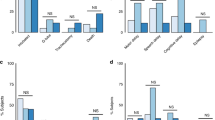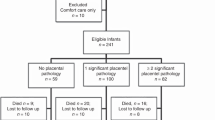Abstract
Objective:
The aim of this study was to examine the relationship between chorioamnionitis and vascular malperfusion on placental pathology and intraventricular hemorrhage (IVH) in premature and small for gestational age (SGA) infants.
Study design:
A retrospective analysis of 263 infants ≤34 weeks gestation or ≤1800 g and their mothers was conducted by chart review for placental pathology and clinical data from 2014 to 2018. Unadjusted and adjusted odds ratios (OR) for the association of placental pathology with IVH were calculated.
Result:
Unadjusted OR showed an association between acute chorioamnionitis and IVH, but logistic regression analysis showed a non-significant adjusted OR between acute or chronic chorioamnionitis with IVH. Maternal vascular malperfusion was significantly associated with increased IVH when controlling for confounders.
Conclusion:
Placental maternal vascular malperfusion is associated with the development of IVH in premature and SGA infants when controlling for other confounders.
This is a preview of subscription content, access via your institution
Access options
Subscribe to this journal
Receive 12 print issues and online access
$259.00 per year
only $21.58 per issue
Buy this article
- Purchase on Springer Link
- Instant access to full article PDF
Prices may be subject to local taxes which are calculated during checkout

Similar content being viewed by others
References
Woods L, Perez-Garcia V, Hemberger M. Regulation of placental development and its impact on fetal growth- new insights from mouse models. Front Endocrinol. 2018;9:570.
Martin RJ, Fanaroff AA, Walsh MC. Fanaroff & Martin’s neonatal-perinatal medicine. 11th ed. Philadelphia: Elsevier; c2020.
Guttmacher AE, Maddox YT, Spong CY. The human placenta project: placental structure, development, and function in real time. Placenta. 2014;35:303–4.
Roescher AM, Timmer A, Erwich JJHM, Bos AF. Placental pathology, perinatal death, neonatal outcome, and neurologic development: a systematic review. PLoS ONE. 2014;9:e89419.
Catov JM, Scifres CM, Caritis SN, Bertolet M, Larkin J, Parks WT. Neonatal outcomes following preterm birth classified according to placental features. Am J Obstet Gynecol. 2017;216:411.e11–14.
Chisholm KM, Heerema-McKenney A, Tian L, Rajani AK, Saria S, Koller D, et al. Correlation of preterm infant illness severity with placental histology. Placenta. 2016;39:61–69.
Volpe JJ. Volpe’s neurology of the newborn. 6th ed. Philadelphia: Elsevier; 2018.
Vergani P, Patamé L, Doria P, Borroni C, Cappellini A, Pezzullo JC, et al. Risk factor for neonatal intraventricular heamorrhage in spontaneous prematurity at 32 weeks gestation or less. Placenta. 2000;21:402–7.
Dexter SC, Pinar H, Malee M, Hogan J, Carpenter MW, Vohr BR. Outcome of very low birth weight infants with histopathologic chorioamnionitis. Obstet Gynecol. 2000;96:172–7.
De Felice C, Toni P, Laurini RN, Stumpo M, Enrico P, Todros T, et al. Early neonatal brain injury in histologic chorioamnionitis. J Pediatr. 2001;138:101–4.
Grafe MR. The correlation of prenatal brain damage with placental pathology. J Neuropathol Exp Neurol. 1994;53:407–15.
Dexter SC, Malee MP, Pinar H, Hogan JW, Carpenter MW, Vohr BR. Influence of chorioamnionitis on developmental outcome in very low birth weight infants. Obstet Gynecol. 1999;94:267–73.
Salafia CM, Minior VK, Rosenkrantz TS, Pezzullo JC, Popek EJ, Cusick W, et al. Maternal, placental and neonatal associations with early germinal matrix/intraventricular hemorrhage in infants born before 32 weeks’ gestation. Am J Perinatol. 1995;12:429–36.
Harteman JC, Nikkles PGJ, Kwee A, Groenendaal F, de Vries LS. Patterns of placental pathology in preterm infants with a periventricular haemorrhagic infarction: association with time of onset and clinical presentation. Placenta. 2012;33:839–44.
Redline RW, Wilson-Costello D, Borawski E, Fanaroff AA, Hack M. The relationship between placental and other perinatal risk factors for neurologic impairment in very low birth weight children. Pediatr Res. 2000;47:721–6.
Zanardo V, Vedovato S, Suppiej A, Trevisanuto D, Migliore M, Di Venosa B, et al. Histological inflammatory responses in the placenta and early neonatal brain injury. Pediatr Dev Pathol. 2008;11:350–4.
DiSalvo D. The correlation between placental pathology and intraventricular hemorrhage in the preterm infant. The developmental epidemiology network investigators. Pediatr Res. 1998;43:15–19.
Vergani P, Patane L, Doria P, Borroni C, Cappellini A, Pezzullo JC, et al. Risk factors for neonatal intraventricular heamorrhage in spontaneous prematurity at 32 weeks gestation or less. Placenta. 2000;21:402–7.
Arayici S, Kadioglu Simsek G, Oncel MY, Eras Z, Canpolat FE, Oguz SS, et al. The effect of histologic chorioamnionitis on the short-term outcome of preterm infants. J Matern-Fetal Neonatal Med. 2004;27:1129–33.
Ogunyemi D, Murillo M, Jackson U, Hunter N, Alperson B. The relationship between placental histopathology findings and perinatal outcome in preterm infants. J Matern Fetal Neonatal Med. 2003;13:102–9.
Soraisham AS, Singhal N, McMillian DD, Sauve RS, Lee SK. Canadian Neonatal Network. A multicenter study on the clinical outcome of chorioamnionitis in preterm infants. Am J Obstet Gynecol. 2009;200:372.e1–6.
Gagliardi L, Rusconi, Da Fre M, Mello G, Carnielli V, Di Lallo D, et al. Pregnancy disorders leading to very preterm birth influence neonatal outcomes: results of the population-based ACTION cohort study. Pediatr Res. 2013;73:794–801.
Papile LA, Burstein J, Burstein R, Koffler H. Incidence and evolution of subependymal and intraventricular hemorrhage: a study of infants with birth weights less than 1,500 gm. J Pediatr. 1978;92:529–34.
Khong TY, Mooney EE, Ariel I, Balmus NCM, Boyd TK, Brundler M, et al. Sampling and definitions of placental lesions Amsterdam placental workshop group consensus statement. Arch Pathol Lab Med. 2016;140:698–713.
Redline RW. Classification of placental lesions. Am J Obstet Gynecol. 2015;213:S21–S28.
Benton SJ, Lafreiere AJ, Gryspan D, Bainbridge SA. A synoptic framework and future directions for placental pathology reporting. Placenta. 2019;77:45–57.
Leviton A, Allred EN, Dammann O, Engelke S, Fichorova R, Hirtz D, et al. Systemic inflammation, intraventricular hemorrhage, and white matter injury. J Child Neurol. 2013;28:1637–45.
Dammann O, Leviton A. Maternal intrauterine infection, cytokines, and brain damage in the preterm newborn. Pediatr Res. 1997;42:1–8.
Yanowitz TD, Jordan JA, Gilmour CH, Towbin R, Bowen AD, Roberts JM, et al. Hemodynamic disturbances in premature infants born after chorioamnionitis: association with cord blood cytokine concentrations. Pediatr Res. 2002;51:310–6.
Rivest S. Molecular insights on the cerebral innate immune system. Brain Behav Immun. 2003;17:13–19.
McAdams RM, Juul SE. The role of cytokines and inflammatory cells in perinatal brain injury. Neurol Res Int. 2012;2:561494.
Stanimirovic D, Satoh K. Inflammatory mediators of cerebral endothelium: a role in ischemic brain inflammation. Brain Pathol. 2000;10:113–26.
Molina-Holgado E, Molina-Holgado F. Mending the broken brain: neuroimmune interactions in neurogenesis. J Neurochem. 2010;114:1277–90.
Villamor-Martinez E, Fumagalli M, Rahim OM, Passera S, Cavallaro G, Degraeuwe P, et al. Chorioamnionitis is a risk factor for Intraventricular Hemorrhage in preterm infants: a systematic review and meta-analysis. Front Physiol. 2018;9:1253.
Alexander JM, Gilstrap LC, Cox SM, McIntire DM, Leveno KJ. Clinical chorioamnionitis and the prognosis for very low birth weight infants. Obstet Gynecol. 1998;91:725–9.
Sarkar S, Kaplan C, Wiswell TE, Spitzer AR. Histological chorioamnionitis and the risk of early intraventricular hemorrhage in infants born < or = 28 weeks gestation. J Perinatol. 2005;25:749–52.
Mehta R, Nanjundaswamy S, Shen-Schwarz S, Petrova A. Neonatal morbidity and placental pathology. Indian J Pediatr. 2006;73:25–28.
Martinez E, Figueroa R, Garry D, Visintainer P, Patel K, Verma U, et al. Elevated amniotic fluid Interleukin-6 as a predictor of neonatal periventricular leukomalacia and intraventricular hemorrhage. J Matern Fetal Investig. 1998;8(Sep):101–7.
Babnik J, Stucin-Gantar I, Kornhauser-Cerar L, Sinkovec J, Wraber B, Derganc M. Intrauterine inflammation and the onset of peri-intraventricular hemorrhage in premature infants. Biol Neonate. 2006;90:113–21.
Morales WJ. The effect of chorioamnionitis on the developmental outcome of preterm infants at one year. Obstet Gynecol. 1987;70:183–6.
Nasef N, Shabaan AE, Schurr P, Iaboni D, Choudhury J, Church P, et al. Effect of clinical and histological chorioamnionitis on the outcome of preterm infants. Am J Perinatol. 2013;30:59–68.
Ment LR, Oh W, Philip AGS, Ehrenkranz RA, Duncan CC, Allan W, et al. Risk factor for early intraventricular hemorrhage in low birth weight infants. J Pediatr. 1992;121:776–83.
Perrone S, Toti P, Toti MS, Badii S, Becucci E, Gatti MG. Perinatal outcome and placental histological characteristics: a single-center study. J Matern Fetal Neonatal Med. 2012;25:110–3.
Redline RW, Pappin A. Fetal thrombotic vasculopathy; the clinical significance of extensive avascular villi. Hum Pathol. 1995;26:80–85.
Saleemuddin A, Tantbirojn P, Sirois K, Crum CP, Boyd TK, Tworoger S, et al. Obstetric and prenatal complications in placentas with fetal thrombotic vasculopathy. Pediatr Dev Pathol. 2012;13:459–64.
Ment LR, Aden U, Bauer CR, Bada HS, Carlo WA, Kaiser JR, et al. Genes and environment in neonatal intraventricular hemorrhage. Semin Perinatol. 2015;39:592–603.
Moscuzza F, Belcari F, Nardini V, Bartoli A, Domenici C, Cuttano A, et al. Correlation between placental histopathology and fetal/neonatal outcome: chorioamnionitis and funisitis are associated to intraventricular haemorrage and retinopathy of prematurity in preterm newborns. Gynecol Endocrinol. 2011;27:319–23.
Author information
Authors and Affiliations
Contributions
MAO contributed to the concept and design of the study, performed chart review/data collection, performed data analysis, and wrote the manuscript. SB contributed to the concept and design of the study, performed placental pathology data review, and revised the manuscript. MM contributed to the design of the study, performed data analysis, and helped write the manuscript. AAP contributed to the concept and design of the study and revised the manuscript.
Corresponding author
Ethics declarations
Conflict of interest
The authors declare that they have no conflict of interest.
Ethics approval and consent to participate
The George Washington University Committee on Human Research International Review Board (IRB) approved this study (IRB# 041826). The study was performed in accordance with the Declaration of Helsinki.
Additional information
Publisher’s note Springer Nature remains neutral with regard to jurisdictional claims in published maps and institutional affiliations.
Rights and permissions
About this article
Cite this article
Oh, M.A., Barak, S., Mohamed, M. et al. Placental pathology and intraventricular hemorrhage in preterm and small for gestational age infants. J Perinatol 41, 843–849 (2021). https://doi.org/10.1038/s41372-021-00954-6
Received:
Revised:
Accepted:
Published:
Issue Date:
DOI: https://doi.org/10.1038/s41372-021-00954-6



